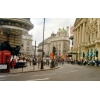|
 Every
capital city has its places of interest to boast and mostly these places are
found in the center, the core of the history of the city. In this regard London is the special
city since its places of interest are located throughout the city, not they are
compacted in the same place. The historians and architects explain that London has no prominent
historical center since the city was formed by merging several settlements
neighboring some time back. One of the most famous and favored by the tourists is
the Piccadilly Circus. Every
capital city has its places of interest to boast and mostly these places are
found in the center, the core of the history of the city. In this regard London is the special
city since its places of interest are located throughout the city, not they are
compacted in the same place. The historians and architects explain that London has no prominent
historical center since the city was formed by merging several settlements
neighboring some time back. One of the most famous and favored by the tourists is
the Piccadilly Circus.
The name of the place is
varied. The point is that the word circus may confuse tourists in association
with the circus place with clowns, athletes and performing animals. Actually circus
in Latin means circle which is the circular road junction which unite several
streets without disturbing the auto traffic in England. There are several similar
interchanges and squares in London,
like Oxford Circus. The square was built under the planning of the architect John
Nash in 1812 at the junction with Regent
Street. That time the street was named Portuguese
though later 1612 Robert Baker purchased a land and built a villa there. Baker was
a tailor famous for selling piccadillies, fashionable rigid kind of collars
with the cogged edges tightened with lace. Later on the house of the
entrepreneur was called Piccadilly Hall where the name covered the street also.
The Piccadilly
Circus is loved by the tourists who find the place convenient since the tube
stations of the London Underground are located there, including the one that
goes from the Heathrow
Airport throughout the
whole city. Since the taxi pay is too high in London, the foreigners who arrive to the city
try to take an underground trip to get to the place. And the Piccadilly
Circus is the most comfortable place for tourists in this regard.
Tourists will
not get astonished with the squares and buildings of the XVIII-XIX centuries in
London City for there are plenty of them. Yet,
the Piccadilly Circus differs from others.
This is a road interchange which is always busy for there are three streets that
meet at the point, namely Regent Street going to the North, Shaftesbury Avenue, going to the North-East and
the Piccadilly Circus which goes to the West with the length of around two kilometers
to the Triumphal Arch. The most attractive sites at the square are the
illuminated advertising hoardings on buildings, starting in the early 1900s and
the place is full of neon signs which look gorgeous especially at nights associated
with the brightness of Broadway in New
York.
However,
the major symbol of London
City is the Shaftesbury
Monument Memorial Fountain, which was erected in 1892-1893 to honor the
philanthropic works of Lord Shaftesbury, who was a famous Victorian politician
and philanthropist. Sooner the statue was called The Angel of Christian Charity and also known as Eros. It is known that
Eros is the mythical Greek God of Love with such attributes as a bow and
arrows. So, the statue became the
London icon to
boast and show to tourists. On the top of it, the image of the statue appears on
the masthead of the Evening Standard
newspaper.
The
Criterion Theatre stands on the south side of Piccadilly
Circus. Apart from the box office area, the entire theatre, is
underground and is reached by descending a tiled stairway. This is one of rare buildings free from advertising boards.
The building of the theatre
was projected by Thomas Verity and opened on March 21, 1874, although preliminary
the plans were to open a concert hall. The theatre closed in 1989 to be totally
renovated, reopening in October 1992.
Besides, there
are buildings of ancient music halls with the local branch of the MadameTussauds Museum.
The other complex is occupied with the set of stores, entertainment places and
the Guinness Museum.
As son as you
want to relax from the prevalence of the classic historical buildings with
pompous establishments inside, you are welcome to go to the Restaurant of
American cuisine Hollywood Planet which is also at the Piccadilly Circus.
If you walk
to the northeastern side of Piccadilly Circus,
you will see the London Pavilion on the corner between Shaftesbury Avenue and Coventry Street. The first building with
the name was built in 1859 as a music hall. In 1885 the new London Pavilion was
constructed, which was also used as a music hall.
When people
mention «it's like Piccadilly Circus»
which is commonly used in Britain
it refers to the place or event which is incredibly busy with people. They say
that if you are at the Piccadilly Circus for
longer time, you will definitely face people you are familiar with.
|